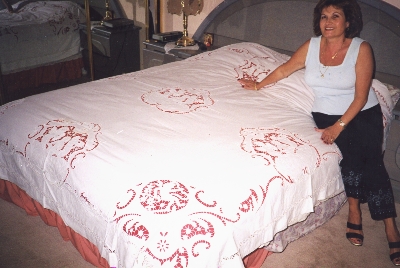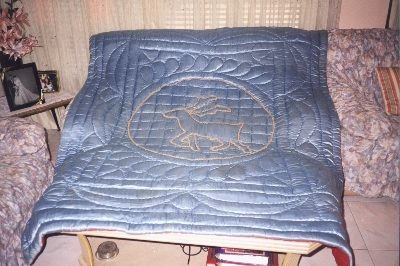Quilt No.728SH - Sophia Haskas
2040 x 1750mm
The quilt was made in 1955 by a local quilt maker in Rhodes, Greece . It was ordered by Eleni Vardavas for her daughter Sophia's 'prika' (dowry). It has always been owned by Sophia. It is not used as 'it is heavy and Sydney has a moderate climate'. [SH]
"A Paploma From Rhodes
This beautiful 'paploma' (quilt) was made in the city of Rhodes, capital of the well-known Greek island, and containing the world's best preserved medieval city. In true Greek tradition, Sophia Haskas' mother, Eleni (Koutsoukou) Vardavas, had ordered several quilts from the local quiltmaker. This one, specially designed, was to be an integral part of Sophia's ' prika' (dowry).
Sophia remembers the paploma-maker at their house in Aghiou Nicolaou, the district where they lived. He came in the springtime, so he could work outside, and he would fluff up the raw cotton, using a 'doxari' (a semi-circular implement with a wire stretched across it). He would then assemble the quilts and stitch them all by hand, using a special, long, thick needle.
This quilt has intricate patterns, each part symbolises an aspect of the rich history of Rhodes. The deer in the centre (overworked in gold braid by Sophia's mother) represents the two bronze deer on stone columns which stand at the entrance to Rhodes harbour, said to mark the position of the famous Colossus of Rhodes. The squares surrounding the deer represent the medieval stonework of the old city; the hibiscus is one of Rhodes' best-known native flowers.
In 1957, together with her mother and three brothers, Sophia came to Australia on the ship 'Skana'; her father had preceded them two years earlier. As with so many of Australia's post-war migrants, the Vardavas family came to Australia for a better life, but for teenage Sophia, it proved a difficult time of living with the disadvantages of not being able to further her education. Then, having trained as an accounting machine operator, she constantly had to fight against the discrimination commonly encountered by people of non-English-speaking backgrounds.
In 1961 when Sophia and Manuel were married, Greek tradition was once again observed when Sophia's paploma was laid out on the wedding bed blue satin side up, and covered with a beautiful white cut-work embroidered bed-spread which had belonged to her mother.
This paploma, with the customs and history it represents, is somehow symbolic of the many years Sophia has been teaching traditional Greek dancing and music to a vast number of young Greek Australians. Sophia and Manuel have three children, George Eleni and Michael."
[Written by Lula Saunders, adapted from interview 6/3/2000, for the National Quilt Register]

Related Quilts:
2040 x 1750mm
Down the centre field of the design and 4 poems embroidered in quite crude chain stitch. Each piece of prose is accompanied by an appliquéd illustration. For example a large clock accompanies a poem of time. 'While shepherds watch their flocks at night�.'is illustrated with a beautiful scene of the manger watched by an angel, cows and sheep. The appliqué and embroidery is executed crudely with large stitches in running and overcasting. The quilt is signed, 'M.J.H. aged 84 yrs.1924.' " [NGA] There is no padding or lining. 1640 x 1540mm
1540 x 950mm
1740 x 1240mm








